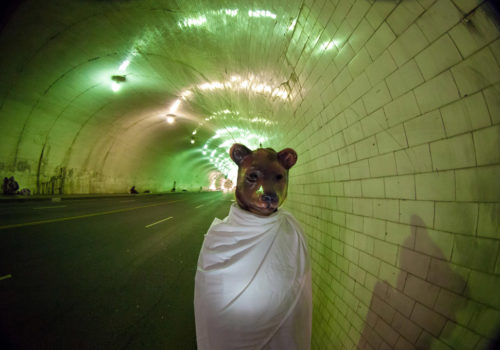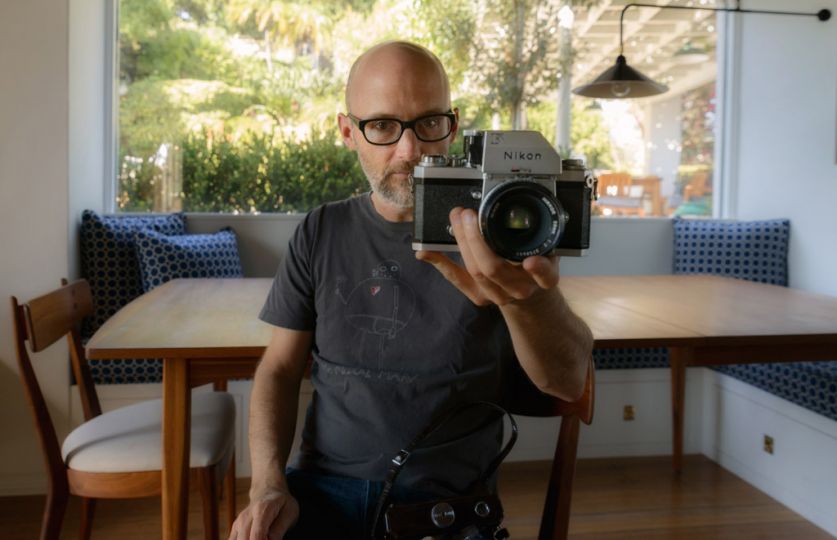In wall sized color prints on display at Project Gallery in Hollywood, humans dressed in robes, faces hidden by animal masks look, perhaps curiously, perhaps menacingly, down at the viewer from clear blue sky and wild Southern California greenery or from between long aisles at a well-stocked supermarket. The work of musician and photographer Moby, the photographs reflect his fascination with the hidden history of the Hollywood Hills, his home since 2011. The project, titled The Innocents, was created concurrently with his latest album, Innocents. In this world, the apocalypse has already happened and these staring figures are cult members and survivors.
Moby thinks deeply about both his photography and his music. Recently, he discussed the meaning of Innocents with designer and photographer Jordan Romanoff. A few days later at his gallery, he continued the discussion with fellow artist Shepard Fairey.
Jordan Romanoff: In the shots there are a lot of masks and robes. It’s very theatrical. Was that a conscious reference?
Moby: There is definitely a theatrical element to it. I’m trying to accomplish a bunch of different things with that. One is almost — and this is going to sound like such a grad student thing to say — but it’s like semiotics contrasted with ontology. Sort of like looking at the essence of something. Like, for example, if you wrap someone in a sheet and put a plastic mask on them, anyone looking at that has an inherent almost aversive reaction. It’s like it’s raising all these questions when the truth is it’s a piece of fabric and a piece of plastic with some printing on it. I’m really fascinated by that, because the original idea behind these people in the sheets and masks is they’re concealing themselves. They’re not trying to look scary, they’re not trying to look intimidating, they’re simply ashamed of themselves and so they’re covering themselves up. And they’re covering themselves up with what is most readily available, which is a sheet and a mask. But in the process they end up being perceived in an odd and intimidating way.
J: I was noticing for instance – that shot in the supermarket – it’s very, not exactly mundane but…
M: It’s completely banal but with a strange utterly terrifying otherworldly figure standing in the middle of it.
J: But then there was something you said earlier about these people wanting to conceal themselves and their shame. I know that Innocents is the title of the show itself. Is the title in reference to the subjects and if so why are they ashamed?
M: It was sort of this evolving idea. Part of it was moving to LA, especially this neighborhood which is sort of ground zero for a lot of pre-millennial, pre-apocalyptic cults. And I thought that it would be interesting to assume that the apocalypse has happened, and that this is a post-apocalyptic cult, this is a cult’s response to the apocalypse and one element of this cult is looking at the last few thousand years of humanity and just feeling the collective sense of shame for what humans have been doing to themselves and to other creatures and feeling a kind of weary shame for humanity and so that’s part of the concealing. That’s why they’re concealing themselves.
J: It seems like there’s been a recent rise of interest in cult symbolism and secret societies and the apocalypse. Why are we so interested in this? Why are you?
M: The word apocalypse is interesting. In fact the first thing I wrote professionally was a review of Apocalypse Now and in order to do that –I had to go find out what the word apocalypse meant. And I thought it meant like destruction or war and actually I think in ancient Greek, etymologically it just means revealing. That’s why the last book of the bible is revelations. It’s the book of the apocalypse, of revealing. I’m not trying to give everything a Christian spin, but it’s that famous quote of “Now we look through a mirror darkly but in the future we will see clearly”. And I think that’s such an interesting idea because I think that as a species that’s what we’re moving towards, a more clear understanding of ourselves, of our place in the universe. So for me that’s my idea of apocalypse. I think a lot of people use apocalypse because it sounds dramatic and filled with destruction. For me it’s just a change from obscurity to clarity. And it’s sort of an understanding that humans are inherently incapable of understanding things objectively. But we can have a little more understanding and a little more clarity than we’ve had up until this point. I feel like it’s important to sort of understand we’re all in this together. So, that’s sort of the thinking behind the cult aspect and the apocalypse aspect, in my mind, not that it’s sophisticated or even interesting. In my mind it’s very multilayered, like I’m trying to do different things. And also it’s pictures so they’re supposed to look cool.
J: If you were starting a cult would these images be part of your mythology?
M: Probably not. First of all I don’t think I have what it takes to become a cult leader because A: I don’t think I really have much interest in starting a cult and B: because usually cults are started by hucksters, like it’s a way of controlling people and having access to their money and sex without doing a lot of work and I’m not really that much interested in other people’s money and promiscuity so it’s like there isn’t the incentive to do so…
J: Is your aesthetic conscious commentary on excess and over information?
M: That’s a good question and I don’t have a good answer. Some aesthetic choices are intuitive, some are taste, some are representative of sort of theme or concept, Somehow I guess I like the idea that the people with the sheets and the masks, are creating a sort of disconcerting stillness. I like the idea of the disconcerting, the strangeness, the other being presented in a very formal way. If you have a picture of someone doing something crazy and you light it crazy and you shoot from a wacky angle and there’s all sorts of weirdness going on and that can be really interesting but you become aware of all of those variables and all those compositional elements. I like the idea of removing that, of just creating a sort of pristine stillness so the strangeness, by contrast, becomes even stranger.
Interview – Jordan Romanoff
Moby images – Innocents, 2013 – http://www.moby.com
Project Gallery – http://projectla.net
Gallery and interview images – Andy Romanoff
Website – http://www.andyromanoff.zenfolio.com
Exhibition
Innocents
by Moby
Until March 30th, 2014
Project LA
1553 N Cahuenga Blvd.
Hollywood, CA 90028
USA

















